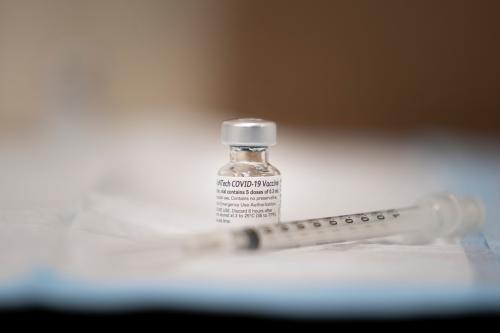Preserving and expanding health insurance coverage for Americans has been a salient goal of the Biden administration. Through legislative and executive initiatives, it has succeeded in bolstering federal programs directed toward this goal. But this success may be short lived. A health insurance cliff looms that threatens to erode coverage gains achieved during Biden’s first two years. As 2022 ebbs, it remains an open question whether the Biden administration will maneuver around this cliff or plummet over it.
The cliff partly emanates from time limits attached to Biden’s efforts to reinvigorate and expand the Affordable Care Act’s (ACA) health insurance exchanges. These exchanges, or marketplaces, allow individuals to buy coverage from participating insurance companies. The ACA authorized federal subsidies for purchasers with incomes from 100% to 400% of the poverty line (i.e., incomes between $26,500 and $106,000 for a family of four in 2021). Biden’s success in securing passage of the American Rescue Plan Act in 2021 greatly enhanced exchange subsidies. Approved on a strict party-line vote, the rescue plan increases the financial support for individuals in the ACA’s 100%-400% of poverty cohort. For the first time it also subsidizes individuals with incomes above the 400% cutoff. The subsidy for this more affluent group kicks in when premium costs for a benchmark exchange plan exceeds 8.5% of an applicant’s household income. An estimated 2.4 million people with incomes between 400% and 600% of the poverty line would benefit from this provision when seeking insurance coverage.
The rescue plan law and Biden’s executive initiatives (e.g., greatly expanded sign-up periods) kindled a surge in exchange enrollments, which reversed four years of declines during the Trump presidency. Sign-ups for exchange insurance for 2021 rose to over 12 million, a five percent increase over the preceding year. Increases continued in 2022 with more than 14.5 million enrolling. But the clock is ticking on this enrollment progress since the American Rescue Plan subsidies apply only to 2021 and 2022. The Congressional Budget Office estimates that failure to renew the subsidies will lead exchange sign-ups to decline by three million, reducing enrollments to what they were the last year of the Trump administration.
The Biden administration’s efforts to avert this enrollment cliff center on securing passage of Build Back Better legislation. The original expansive version of this legislation floundered in late 2021 when, in the face of unified Republican opposition and two Democratic senators, Joe Manchin of West Virginia and Kristen Sinema of Arizona, declined to support it. This setback prompted the Biden administration to seek approval of a less expensive “skinny” version of Build Back Better. This version is likely to include a continuation of the enhanced exchange subsidies. The legislation has some chance of winning Sen. Manchin’s support since his opposition to the original bill did not stem from its health care provisions. Still, Manchin has indicated that his backing of any such measure rests on whether it also includes tax reforms and does not add to the federal deficit. Prospects for legislation extending the exchange subsidies are, therefore, uncertain at best.
As if this enrollment cliff were not sufficiently daunting for the Biden administration, the pending termination of the Covid-inspired public health emergency also looms. Legislation bolstering Medicaid in response to the pandemic forged this feature of the cliff. Medicaid is the largest federal grant program to the states, which subsidizes health coverage for low-income Americans. The federal contribution ordinarily covers from 50% to about 75% of state spending (the match rate) on the program with less affluent states enjoying proportionately greater federal subsidies. The Families First Coronavirus Response Act of March 2020 authorized a 6.2 percentage point increase in the Medicaid match rate to the states starting on January 1, 2020, and continuing until the federally declared public health emergency expires. To receive this enhanced subsidy, a state had to refrain from making Medicaid eligibility criteria more stringent or disenrolling current beneficiaries. This meant that beneficiaries whose incomes subsequently exceeded the level for Medicaid eligibility would remain enrolled for the duration of the public health emergency. Subsequently, Medicaid enrollments soared by 25% from 64 million in February 2020 just before the pandemic to an all-time high of 80 million in mid-2022.
Once the president terminates the public health emergency, however, states will lose the enhanced federal subsidy and will need to do timely, income-based eligibility redeterminations for enrollees or face federal fiscal penalties. This process threatens to fuel a decline in health insurance coverage. Many Medicaid beneficiaries would have incomes too high to qualify for the program any longer and fail to transition smoothly to the ACA’s insurance exchanges. Many others would continue to meet Medicaid eligibility criteria but lose coverage for failure to comply with the often-burdensome administrative requirements for renewal.
The limits to state capacity to process renewal applications compound problems. The National Association of Medicaid Directors has expressed concern that many states lack adequate numbers of well-trained, experienced staff to effectively perform the renewal function in a timely way. While some states plan to cope with their administrative capacity limitations by contracting out the renewal function, it is far from clear whether these private entities are any more equipped to perform the task. Moreover, some states, eager to pare Medicaid costs, may incentivize contractors in ways that undercut the take-up of applicants who meet the program’s eligibility criteria. These factors have prompted the Kaiser Family Foundation to project that at least 5.3 million and possibly as many as 14.2 million enrollees will lose Medicaid coverage when the public health emergency ends.
The Biden administration has acted to reduce the threat of a precipitous decline in insurance coverage. While the Trump administration had given states six months to complete the redetermination process, the Biden administration pledged to give them 60 days advance notice of the health emergency’s end and another 14 months to make eligibility redeterminations. The White House also moved to establish a special year-round open enrollment period on the ACA exchanges to transition those no longer eligible for Medicaid to this coverage. The Biden administration has also provided a steady stream of guidance encouraging states to adopt client-friendly renewal practices. It has threatened to penalize states financially that adopt burdensome renewal procedures that skirt Medicaid law (e.g., by requiring in-person interviews for renewal applicants). A key issue for the Biden administration is when to end the public health emergency. Many health care providers and advocates for low-income beneficiaries have urged Biden to extend the emergency at least through October. It appears likely that his administration will not only accede to this request, but postpone this politically painful decision until after the election.
On balance, uncertainty shrouds the degree to which the Biden administration will be able to avoid the health insurance cliff. In the case of the ACA’s exchanges, this uncertainty stems from a legislative challenge. Will Biden secure passage of a version of Build Back Better that extends the American Rescue Plan’s subsides for those seeking coverage? In the case of the pandemic-inspired Medicaid expansion, the uncertainty springs from an implementation challenge where the states hold the key cards. Whatever steps federal officials take to ease the threat to insurance coverage associated with the end of the public health emergency, they must rely on the states to implement them. Given that states vary greatly in their administrative capacity and commitment to preserving Medicaid enrollments, averting this coverage cliff is far from assured.






Commentary
Can Biden avert a health insurance cliff?
June 10, 2022